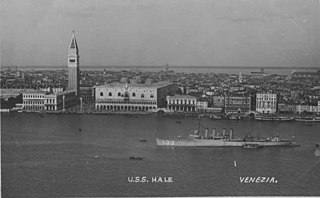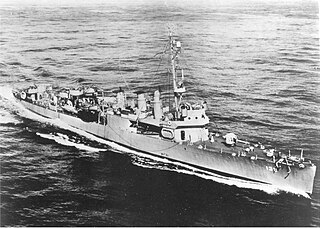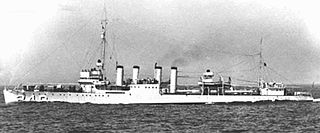
USS Cole (DD-155) was a Wickes-class destroyer in the United States Navy during World War II, later reclassified as AG-116. It was named for Edward B. Cole, a United States Marine Corps officer who died as a result of the wounds he received at the Battle of Belleau Wood.

USS Jacob Jones (DD-130), named for Commodore Jacob Jones USN (1768–1850), was a Wickes-class destroyer. She was sunk by a German submarine in 1942 during World War II.

USS Dickerson (DD-157) was a Wickes-class destroyer in the United States Navy, and was converted to a high-speed transport at Charleston, South Carolina and designated APD-21 in 1943. She was named for Mahlon Dickerson (1770–1853), Secretary of the Navy from 1834 to 1838.

USS Lamberton (DD-119)/(DMS-2) was a Wickes-class destroyer in the United States Navy in commission from 1918 to 1922 and from 1930 to 1946. She saw service during World War II. She was the only ship named for Benjamin P. Lamberton, a rear admiral who served with Admiral Dewey in the Battle of Manila Bay in 1898 during the Spanish–American War.

The first USS Philip (DD–76) was a Wickes-class destroyer in the United States Navy during World War I, later transferred to the Royal Navy as HMS Lancaster. She was named for John Woodward Philip.

The first USS Hale (DD–133) was a Wickes-class destroyer in the United States Navy during World War I, later transferred to the Royal Navy as HMS Caldwell (I20). She was named for Senator Eugene Hale.

USS Kennison (DD–138) was a Wickes-class destroyer in the United States Navy during World War II, later redesignated AG-83. She was the first ship named for William Kennison.

The third USS Lawrence (DD-8) was a Lawrence-class destroyer, which was a sub-class of Bainbridge-class destroyer, in the United States Navy. She was named for Captain James Lawrence.

USS Hatfield (DD-231/AG-84) was a Clemson-class destroyer in the United States Navy during World War II. She was named for John Hatfield, killed in action 1813. As of 2021, no other ship of the U.S. Navy has been named Hatfield.

USS Fox (DD-234/AG-85) was a Clemson-class destroyer in the United States Navy during World War II. She was the fourth ship named for Gustavus Vasa Fox, Assistant Secretary of the Navy during the Civil War.

USS Humphreys (DD-236/APD-12) was a Clemson-class destroyer in the United States Navy during World War II. She was named for Joshua Humphreys, a pioneer US shipbuilder.

USS Sturtevant (DD-240) was a Clemson-class destroyer in the United States Navy during World War II. She was the first ship named for Albert D. Sturtevant.

The third USS Bainbridge (DD-246) was a Clemson-class destroyer in the United States Navy during World War II. She was named for Commodore William Bainbridge, who served in the War of 1812 and the First and Second Barbary Wars.

USS Goff (DD-247) was a Clemson-class destroyer in the United States Navy during World War II. She was named for Secretary of the Navy Nathan Goff, Jr.

The fourth USS Lawrence (DD-250) was a Clemson-class destroyer in the United States Navy during World War II. She was named for James Lawrence.

USS John W. Weeks (DD-701), an Allen M. Sumner-class destroyer, was named for John Wingate Weeks, who attained the rank of rear admiral. Weeks was elected to the United States House of Representatives where he served until entering the United States Senate in 1913. He became Secretary of War on 4 March 1921.

USS Alfred A. Cunningham (DD-752), an Allen M. Sumner-class destroyer, is the only ship of the United States Navy to be named for Alfred Austell Cunningham, a USMC officer and aviator.

USS James C. Owens (DD-776), an Allen M. Sumner-class destroyer, is the only ship of the United States Navy FRAM II class to be named for Lieutenant James C. Owens Jr., a member of Torpedo Squadron 8 on board USS Hornet. His entire squadron was lost in an attack against Japanese aircraft carriers 4 June during the Battle of Midway. Lt. Owens received the Navy Cross and the Presidential Unit Citation (US) posthumously.

USS John Hood (DD-655) was a Fletcher-class destroyer of the United States Navy, named for Rear Admiral John Hood (1859–1919).

The third USS Keppler (DD/DDE-765) was a Gearing-class destroyer in the United States Navy during the Korean War and the Vietnam War. She was named for Boatswain's Mate First Class Reinhardt J. Keppler (1918–1942), who was posthumously awarded the Medal of Honor for "extraordinary heroism" during the Naval Battle of Guadalcanal.




















